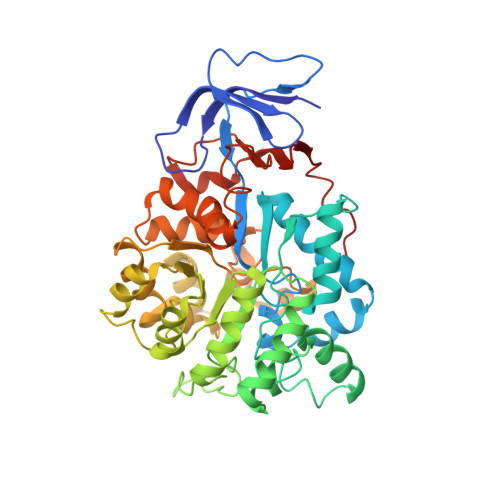Evolutionary Expansion of the Amidohydrolase Superfamily in Bacteria in Response to the Synthetic Compounds Molinate and Diuron.
Sugrue, E., Fraser, N.J., Hopkins, D.H., Carr, P.D., Khurana, J.L., Oakeshott, J.G., Scott, C., Jackson, C.J.(2015) Appl Environ Microbiol 81: 2612-2624
- PubMed: 25636851
- DOI: https://doi.org/10.1128/AEM.04016-14
- Primary Citation of Related Structures:
4WGX, 4WHB - PubMed Abstract:
The amidohydrolase superfamily has remarkable functional diversity, with considerable structural and functional annotation of known sequences. In microbes, the recent evolution of several members of this family to catalyze the breakdown of environmental xenobiotics is not well understood. An evolutionary transition from binuclear to mononuclear metal ion coordination at the active sites of these enzymes could produce large functional changes such as those observed in nature, but there are few clear examples available to support this hypothesis. To investigate the role of binuclear-mononuclear active-site transitions in the evolution of new function in this superfamily, we have characterized two recently evolved enzymes that catalyze the hydrolysis of the synthetic herbicides molinate (MolA) and phenylurea (PuhB). In this work, the crystal structures, mutagenesis, metal ion analysis, and enzyme kinetics of both MolA and PuhB establish that these enzymes utilize a mononuclear active site. However, bioinformatics and structural comparisons reveal that the closest putative ancestor of these enzymes had a binuclear active site, indicating that a binuclear-mononuclear transition has occurred. These proteins may represent examples of evolution modifying the characteristics of existing catalysts to satisfy new requirements, specifically, metal ion rearrangement leading to large leaps in activity that would not otherwise be possible.
Organizational Affiliation:
Research School of Chemistry, Australian National University, Canberra, ACT, Australia.















